|
|
|
Sort Order |
|
|
|
Items / Page
|
|
|
|
|
|
|
| Srl | Item |
| 1 |
ID:
077354
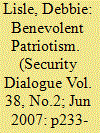

|
|
|
|
|
| Publication |
2007.
|
| Summary/Abstract |
This article examines the role of contemporary art in a post-9/11 context through The American Effect exhibition at the Whitney Museum of American Art in New York in 2003. This exhibition displayed a range of artworks from around the world that specifically engaged with, commented upon and interrogated the USA's pre-eminent position as a global superpower. In the politically charged climate after 9/11, the exhibition offered itself as a critical voice amid the more obvious patriotic clamour: it was one of the places where Americans could ask (and answer) the question, `Why do they hate us so much?' Although The American Effect claimed to be a space of dissent, it ultimately failed to question, let alone challenge, US global hegemony. Instead, the exhibition articulated a benevolent patriotism that forced artwork from other nations into supplicating and abject positions, and it obscured the complex discursive networks that connect artists, curators, critics, audiences and art museums
|
|
|
|
|
|
|
|
|
|
|
|
|
|
|
|
| 2 |
ID:
077352
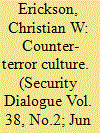

|
|
|
|
|
| Publication |
2007.
|
| Summary/Abstract |
This article examines themes of terrorism and counter-terrorism in US popular culture, focusing on eight cinematic or televisual works from the pre- and post-9/11 environment. Each of these works explores the dilemmas posed by terrorism, counter-terrorist mobilization, and occupation and resistance in fictional spaces. Three of the works - 24, The Agency, and The Grid - are narratives that attempt to simulate the activities of counter-terrorist operations in, respectively, a wholly fictional Counter Terrorist Unit; the Central Intelligence Agency; and ad hoc intelligence and tactical groups combing CIA, FBI, NSC, and MI5 agents. The other five works are more removed from an explicit attempt to mimic `reality': The X-Files, The Matrix Trilogy, Alias, The 4400, and Battlestar Galactica. In all of these works, the dangers to human rights posed by both overt and covert security operations lie at the core of their narrative structures.
|
|
|
|
|
|
|
|
|
|
|
|
|
|
|
|
| 3 |
ID:
077356
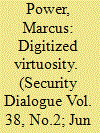

|
|
|
|
|
| Publication |
2007.
|
| Summary/Abstract |
In post-9/11 America, digital war games have increasingly come to provide a space of cyber-deterrence where Americans are able to `play through' the anxieties that attend uncertain times and new configurations of power. This article seeks to examine the increasingly close relationship between the US military and the digital-game industry, along with the geographies of militarism that this has produced. Focusing on the contribution that digital war games make to a culture of perpetual war and in the manufacture of consent for US domestic and foreign policy, the Pentagon's mobilization and deployment of digital games as an attempt to create a modern version of the noble war fantasy is critically examined. With particular reference to America's Army, the official US Army game, the article seeks to examine the influence of digital war games in the militarization of popular culture and in shaping popular understandings of geopolitics
|
|
|
|
|
|
|
|
|
|
|
|
|
|
|
|
| 4 |
ID:
077355
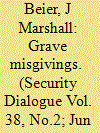

|
|
|
|
|
| Publication |
2007.
|
| Summary/Abstract |
Days after the December 1890 US Army massacre of Lakota refugees at Wounded Knee, South Dakota, commercial photographer George Trager photographed the Army burial detail as they cleared the site and committed the dead to a mass grave. Widely circulated as post-cards, Trager's photographs merged with a broader colonial narrative, allegorically and cathartically sketching a heroic account of a dire confrontation between `civilization' and `savagery'. Reconfirming dominant ideas about an inherently dangerous foe, the Wounded Knee photos worked through colonial imaginaries in ways that reinforced a Euro-American monopoly on legitimacy in war. More recently, widely circulated photos of abuse of prisoners by US soldiers at Baghdad's Abu Ghraib Prison have effected a disruption of the operant war narrative. Whereas Trager's photographs worked to sustain stable definitions of moral `civilization' and `savage' depravity, those from Abu Ghraib have undermined the legitimacy of US conduct in Iraq. In this article, I consider these differing effects with reference to photographic composition and the popular functions of allegory and catharsis
|
|
|
|
|
|
|
|
|
|
|
|
|
|
|
|
| 5 |
ID:
077351
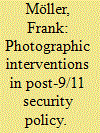

|
|
|
|
|
| Publication |
2007.
|
| Summary/Abstract |
Regardless of its cultural and discursive turn, the field of security studies has not yet paid sufficient attention to visual culture. In particular, approaches that focus on the articulation of security have been quite inattentive to images. With respect to post-9/11 security policy, it is argued here that the images of planes crashing into the World Trade Center have become not only a legitimacy provider for security policy but also part of every person's visual reservoir and pictorial memory, on which the successful articulation of security in part depends. It is therefore suggested to link the study of securitization with the study of both images and pictorial memory. The present article, by discussing three visual projects revolving around 9/11, looks for desecuritizing potential in photography and examines the extent to which photography can offer oppositional interventions in security policy. However, the surplus meaning that images inevitably carry with them, while limiting the securitizing potential of images, also reduces the extent to which opposition can rely on images
|
|
|
|
|
|
|
|
|
|
|
|
|
|
|
|
| 6 |
ID:
077349
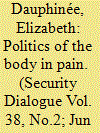

|
|
|
|
|
| Publication |
2007.
|
| Summary/Abstract |
Images of the body in pain are the primary medium through which we come to know war, torture and other pain-producing activities. The Cartesian paradigm of subjectivity suggests that pain is an interior event that can only be imperfectly expressed through language or visuality. This creates a significant disjuncture between the body that experiences pain and the one who observes this body through the technologies of visual culture. The imperative to make pain visible is driven by the desire to access the pain of the other; but, in the context of the Cartesian subject, this access is simultaneously impossible. This article explores the ethics of using such imagery for projects that seek to resist or oppose war and torture, and suggests alternative ways of understanding and responding to bodies in pain
|
|
|
|
|
|
|
|
|
|
|
|
|
|
|
|
| 7 |
ID:
077350
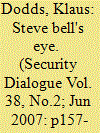

|
|
|
|
|
| Publication |
2007.
|
| Summary/Abstract |
This article explores the geopolitical representations of British cartoonist Steve Bell. The Bush administration's so-called `War on Terror' provides a political and visual backdrop to a detailed analysis of a number of Bell's editorial cartoons in the British newspaper The Guardian, as well as an interview conducted with the artist. As with cartoonists in the past, Bell's work seeks to provide a contemporary view of events in a manner that calls into question dominant practices and representations, such as the USA's `War on Terror'. This article is intended to further contribute to the necessary debate on how visual images and technologies are put to work for the purpose of making sense of the geopolitical world around us.
|
|
|
|
|
|
|
|
|
|
|
|
|
|
|
|
| 8 |
ID:
077353


|
|
|
|
|
| Publication |
2007.
|
| Summary/Abstract |
This article engages with a form of visual culture that is, W. J. T. Mitchell (2002: 170) reminds us, `not limited to the study of images and media', but extends also `to everyday practices of seeing and showing'. In the spirit of this openness to multiple manifestations of the domain of the visual and visual practices, the article explores how a particular mode of vigilant or watchful visuality has come to be mobilized in the `homefront' of the so-called war on terror. In homeland security programmes from border and financial screening to Highway Watch, how has sight become represented as the sovereign sense on the basis of which security decisions can be taken? Taking its illustrative cue from Paul Haggis's film Crash, and from a body of work that conceives of touch as `integral to' seeing, the article asks how we might subvert watchful politics by seeing seeing differently.
|
|
|
|
|
|
|
|
|
|
|
|
|
|
|
|
|
|
|
|
|